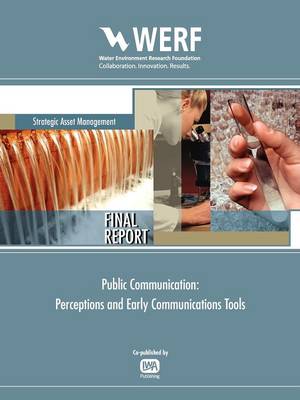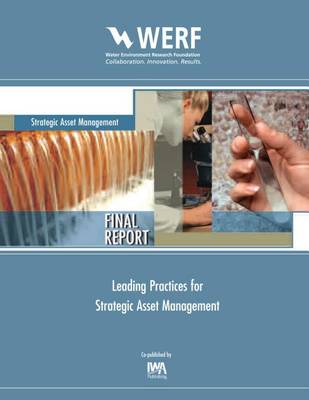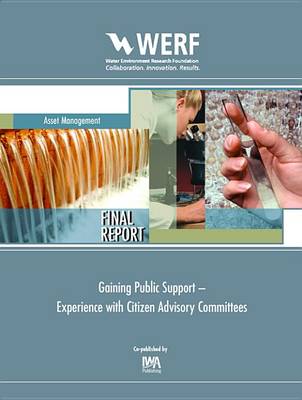WERF Research Report
3 total works
Public understanding leading to support for investment in aging water infrastructure is absolutely essential in order to close the "gap" between projected and current funding levels. In response to the need identified by its utility members, the Water Environment Research Foundation has funded a research program on Strategic Asset Management program (SAM) for wastewater and water utilities.
One objective of the research program included the development of an effective communications package - aimed at public officials, policy makers, utility managers and rate payers - to encourage the adoption of SAM and provide guidance on its implementation in the utility environment. This report provides the initial results of the research program to understand elected and appointed officials' perspectives on the issue of asset management and infrastructure sustainability. It uses results of a survey, focus groups, interviews and a case study to understand how public support for infrastructure sustainability can be gained. Relevant and readily usable tools that focus on the infrastructure sustainability issue are identified. Messages that elected, appointed, and salaried public officials can use in communication with their stakeholders have been identified.
One objective of the research program included the development of an effective communications package - aimed at public officials, policy makers, utility managers and rate payers - to encourage the adoption of SAM and provide guidance on its implementation in the utility environment. This report provides the initial results of the research program to understand elected and appointed officials' perspectives on the issue of asset management and infrastructure sustainability. It uses results of a survey, focus groups, interviews and a case study to understand how public support for infrastructure sustainability can be gained. Relevant and readily usable tools that focus on the infrastructure sustainability issue are identified. Messages that elected, appointed, and salaried public officials can use in communication with their stakeholders have been identified.
Available as eBook only.
In response to the need identified by its utility members, the Water Environment Research Foundation has funded a research program on Strategic Asset Management (SAM) Implementation and Communication for wastewater and water utilities.
One objective of the research program included understanding the leading practices that contribute to a strategic asset management program. Leading practices in six key areas are documented in this report - Accounting and Costing, Strategic Asset Planning and Asset Management Plans, Maintenance, Organization and People, Secondary Data and Knowledge and Business Risk Management. Utility examples and lessons learned are included to guide a utility that desires to establish a strategic asset management program. An objective of the research program has been to improve economic life and realize cost savings in the provision of water and wastewater system services. In particular, the research documented in this report has focused on identifying and documenting leading strategic asset management practices used by utilities. Leading practices were identified, documented and validated through site visits and a leading practices research forum conducted in June 2010.
Throughout this report, reference will made to strategic asset management practices. Strategic asset management practices focus on the inherently long life cycle of the vast majority of water and wastewater system assets. To achieve improved economic life and realize cost savings, utility managers must think holistically onhow capital and operations and maintenance investments are made. The intention of the research documented in this report is to assist utility managers with this process.
In response to the need identified by its utility members, the Water Environment Research Foundation has funded a research program on Strategic Asset Management (SAM) Implementation and Communication for wastewater and water utilities.
One objective of the research program included understanding the leading practices that contribute to a strategic asset management program. Leading practices in six key areas are documented in this report - Accounting and Costing, Strategic Asset Planning and Asset Management Plans, Maintenance, Organization and People, Secondary Data and Knowledge and Business Risk Management. Utility examples and lessons learned are included to guide a utility that desires to establish a strategic asset management program. An objective of the research program has been to improve economic life and realize cost savings in the provision of water and wastewater system services. In particular, the research documented in this report has focused on identifying and documenting leading strategic asset management practices used by utilities. Leading practices were identified, documented and validated through site visits and a leading practices research forum conducted in June 2010.
Throughout this report, reference will made to strategic asset management practices. Strategic asset management practices focus on the inherently long life cycle of the vast majority of water and wastewater system assets. To achieve improved economic life and realize cost savings, utility managers must think holistically onhow capital and operations and maintenance investments are made. The intention of the research documented in this report is to assist utility managers with this process.
Public understanding leading to support for investment in aging water infrastructure is absolutely essential in order to close the "gap" between projected and current funding levels. In response to the need identified by its utility members, the Water Environment Research Foundation has funded a research program on Strategic Asset Management (SAM) Implementation and Communication for wastewater and water utilities.
One objective of the research program included understanding the experience of utilities with citizen advisory committees to gain support for issues related to infrastructure sustainability and asset management. A variety of experiences are documented in this report. Lessons learned that can guide a utility that desires to establish a citizen advisory committee are identified in the areas of formation, logistics, goals and expected results.
One objective of the research program included understanding the experience of utilities with citizen advisory committees to gain support for issues related to infrastructure sustainability and asset management. A variety of experiences are documented in this report. Lessons learned that can guide a utility that desires to establish a citizen advisory committee are identified in the areas of formation, logistics, goals and expected results.


